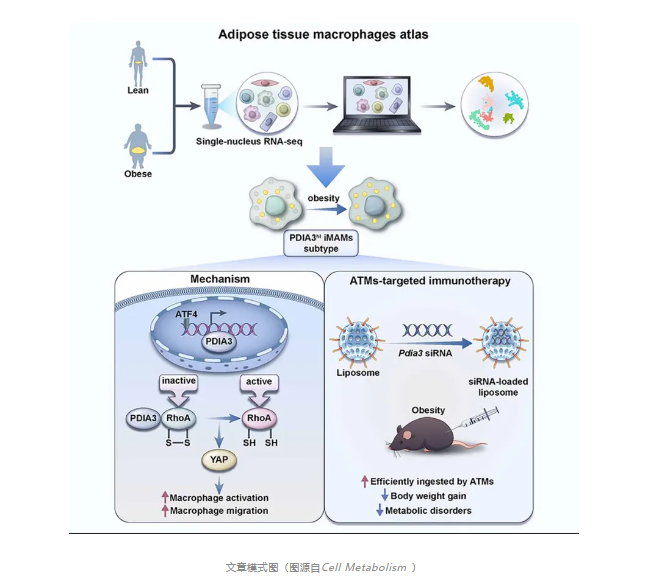18
2024
-
09
Huazhong University of Science and Technology Wang Cong Yi/Sun Fei found in obese environment really pathogenic adipose tissue macrophage subsets
Author:
Adipose tissue macrophages (ATMs) play an important role in maintaining adipose tissue homeostasis and coordinating metabolic inflammation.Given the extensive functional heterogeneity and phenotypic plasticity of ATMs, there is a need to identify truly pathogenic subpopulations of ATMs in the context of obesity.
On September 17, 2024, Wang cong-yi and sun Fei of Huazhong university of science and technology jointly communicated inCell MetabolismPublished online entitled"PDIA3 defines a novel subset of adipose macrophages to exaggation the development of obesity and metabolic disordersThe study performed single-core RNA sequencing (snRNA-seq) and revealed a distinct subpopulation of ATMs, definedATF4hiPDIA3hiACSL4hiCCL2hiInflammation and Metabolically Activated Macrophages (iMAMs) in which PDIA3 is required to maintain their migratory and pro-inflammatory properties.
Mechanically, ATF4 acts as a metabolic stress sensor to transcribe PDIA3, which then exerts redox control on RhoA activity through RhoA-Yap signaling and enhances the pro-inflammatory and migratory properties of iMAMs. Pdia3 small interfering RNA (siRNA)-loaded liposomes effectively inhibit fat inflammation and high-fat diet (HFD)-induced obesity.Taken together, the data from this study support that strategies to target iMAMs by inhibiting the expression or activity of PDIA3 may be a viable approach for the clinical treatment of obesity and metabolic disorders.
Activated M1 macrophages secrete multiple chemokines and cytokines in the obese stateSuch as CC motif ligand -2 (CCL2, also known as monocyte chemoattractant protein -1 [MCP-1]), interleukin (IL)-6, tumor necrosis factor (TNF)-α, etc., spread inflammation and damage adipocyte function. However, because macrophages are extremely dynamic and plastic in different tissues, and the so-called M1 macrophage fraction is beneficial in combating infection of adipose tissue and other organs, the overly simplified classification of M1/M2 macrophage phenotype has been severely challenged.Therefore, in order to develop an effective macrophage-targeted immunotherapy for metabolic diseases, it is necessary to identify the truly pathogenic ATM subsets that contribute to the pathogenesis of human obesity.

Chongqing Chongfan Technology Co., Ltd. Optical platform film thickness meter OCT optical coherence tomography LabVIEW control
Previous
Previous
LATEST NEWS
2024-09-16
Tsinghua University Xiao Bailong/Peking University Ouyang Kunfu Collaboration Reveals Key Phosphorylation Sites That Regulate Piezo1 Mechanical Sensitivity and Mechanotransduction Function in Vivo
Piezo1 is a mechanically activated cation channel that can convert mechanical forces into various physiological processes. Due to its large protein size of more than 2500 amino acids and complex 38 transmembrane helix topology, how Piezo1 is post-translationally modified to regulate its mechanotransduction function in vivo remains unexplored.
2024-09-18
Huazhong University of Science and Technology Wang Cong Yi/Sun Fei found in obese environment really pathogenic adipose tissue macrophage subsets
Adipose tissue macrophages (ATMs) play an important role in maintaining adipose tissue homeostasis and coordinating metabolic inflammation. Given the extensive functional heterogeneity and phenotypic plasticity of ATMs, there is a need to identify truly pathogenic subpopulations of ATMs in the context of obesity.
2024-09-14
Wang Su's team at Southeast University found that microenvironmental glial cells regulate stem cell self-renewal and differentiation by delivering iron to neural stem cells through ferritin
The study of neural stem cells is of great significance for the treatment of neural development and nervous system diseases. However, the regulation mechanism of neural stem cells has not been fully elucidated, especially the regulation of neural stem cells by microenvironment is relatively less known.
2024-09-14
Subversion of the past! Tsinghua University Dai Qionghai/Guo Zengcai/Wu Jiamin Cooperation Latest Cell
A comprehensive understanding of physiopathological processes requires non-invasive live three-dimensional (3D) imaging on different spatial and temporal scales. However, huge data throughput, optical non-uniformity, surface irregularities, and phototoxicity pose huge challenges, resulting in inevitable trade-offs between volume size, resolution, speed, sample health, and system complexity.
2024-09-11
The latest research by Guo Jianping/Cheng Chao/Bo Lang of Sun Yat-sen University confirms that palmitic acid can suppress virus infection by activating innate immunity!
Innate immunity is the primary defense against viral and microbial infections. The exact effect of cellular metabolites, particularly fatty acids, on antiviral innate immunity remains largely elusive.

